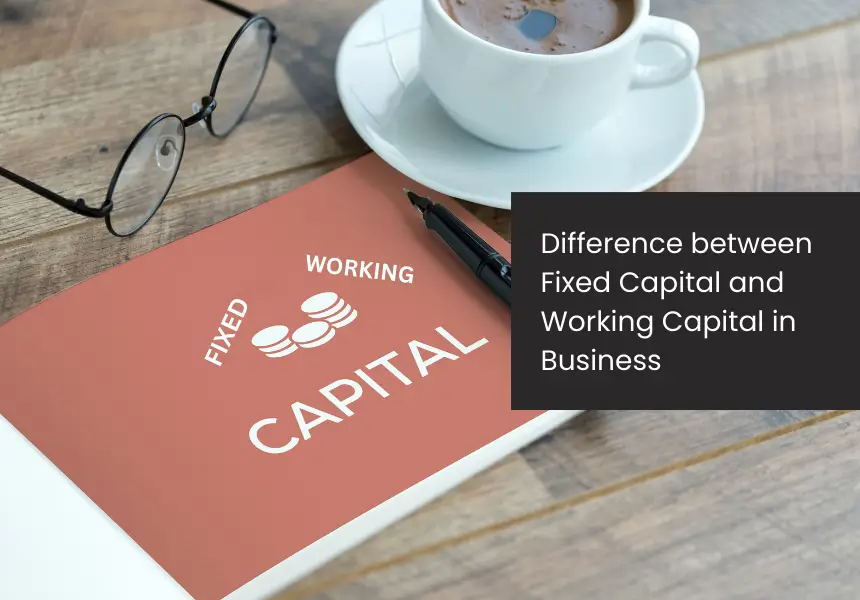
Every business requires financial resources to fuel its operations, expand its reach, and sustain growth. These financial requirements can be categorized based on their purpose and duration. Fixed capital is used for long-term investments, such as acquiring machinery or building infrastructure, while working capital supports the short-term needs of a business, like managing daily operational expenses.
To address these financial requirements, businesses often turn to different financing solutions, such as loans, trade credit, or overdraft facilities. While both fixed and working capital are important for a business’s success, their purposes, sources, and impacts on operations differ significantly, shaping the way businesses allocate and manage resources.
Imagine you’re building a house. Fixed capital is like the bricks and foundation, providing the essential structure for long-term stability. On the other hand, working capital is like the water and electricity that ensure daily functioning. Just as these are important for a home, fixed capital and working capital are indispensable for a successful business.
But what exactly is the difference between fixed capital and working capital, and why does it matter for your business? Whether you’re planning for future growth or ensuring seamless daily operations, understanding the difference between the two is important for making smarter financial decisions.
What is Working Capital?
Working capital is the money a business invests to maintain its daily operations and short-term expenses. It is calculated by determining the difference between current assets (including cash, accounts receivable, and inventory) and current liabilities (including short-term loans, accounts payable, and accrued expenses).
It ensures that the company has the liquidity needed to cover operational costs, maintain inventory levels, and fulfill short-term obligations. A positive working capital indicates that the business has sufficient resources to sustain its operations, whereas a negative figure may signal potential financial challenges.
By maintaining an optimal working capital balance, businesses can support their ongoing operations and ensure smooth functionality.
What is Fixed Capital?
Fixed capital refers to the long-term funds a business invests in acquiring and maintaining physical assets necessary for its operations. These assets, such as land, buildings, machinery, and equipment, help in supporting production and are not intended for immediate sale or consumption. Unlike working capital, which covers short-term operational needs, fixed capital is used to establish and sustain the core infrastructure of a business.
Fixed capital assets are durable and often used for over a year. They contribute to generating revenue for a prolonged period of time . These assets are usually resold or reused rather than liquidated, making them a permanent component of a firm’s financial structure. These investments are important during the initial stages of a business, as they help set up operations, along with contributing to the maintenance and expansion of the company’s activities in the long run.
Difference between Fixed Capital and Working Capital
Fixed capital and working capital are two essential financial resources for a business, each serving different purposes. Here’s how they differ:
| Basis | Fixed Capital | Working Capital |
| Definition | Funds invested in long-term assets for extended business use. | Funds allocated towards ensuring smooth day-to-day operations. |
| Time Period | Used for long-term purposes, often lasting several years. | Focuses on short-term needs, and may fluctuate based on operational demands. |
| Liquidity | Not liquid; cannot be quickly converted into cash. | Highly liquid and readily available for immediate use. |
| Purpose | Serves strategy-oriented goals, such as expansion or modernization. | Supports operational objectives, ensuring smooth daily functioning. |
| Composition | Includes non-current assets like land, buildings, machinery, and equipment. | Comprises current assets such as cash, inventory, and accounts receivable, along with current liabilities such as short-term debts and accounts payable. |
| Flexibility | Difficult to adjust or modify in the short term. | Easily adjustable to meet changing business requirements. |
| Depreciation | Assets depreciate over time due to wear and tear or obsolescence. | Does not depreciate, as it primarily consists of liquid or semi-liquid assets. |
| Examples | Factories, infrastructure, vehicles, and heavy machinery. | Cash reserves, inventory, raw materials, and trade receivables. |
Similarities between Fixed Capital and Working Capital
Fixed capital and working capital are important for a business’ financial framework, sharing several similarities despite their different purposes. Here’s how they are similar:
1. Part of the Capital Structure
Both fixed capital and working capital are a major part of a business’ overall capital structure, ensuring smooth operations and long-term sustainability.
2. Significant for Financial Health
Both are important for maintaining a business’ financial stability. Proper management of working and fixed capital contributes to the business’ operational efficiency and growth.
3. Need for Strategic Management
It is essential to effectively monitor working and fixed capital and plan their utilization to optimize financial performance and ensure that resources are allocated appropriately.
4. Influence from External Factors
Both fixed and working capital are influenced by economic factors like inflation, interest rates, and broader economic conditions, which can affect their cost and availability.
5. Adjustability Over Time
Businesses can adjust their fixed and working capital allocations according to the changing requirements and objectives. This is to ensure that they align with the growth strategies.
Conclusion
Fixed capital and working capital address the various financial needs of a business. Fixed capital supports long-term investments, such as acquiring long-term assets or expanding infrastructure, while working capital provides the liquidity needed for everyday operations.
LoanTap provides businesses with unsecured business loans up to ₹10 lakh, customized to match their unique requirements. We offer quick approvals, flexible repayment tenures, and require minimal documentation. Whether it’s financing strategic expansion or managing operational expenses, LoanTap has got you covered.
Frequently Asked Questions
Which type of capital is better for expanding a business?
Fixed capital is generally better for expansion as it helps businesses finance long-term assets and infrastructure.
Can working capital be used for buying long-term assets?
No, working capital is not meant for large asset purchases. It helps businesses cover day-to-day operational expenses such as bills, salaries or buying inventory.
How can LoanTap help businesses with their fixed and working capital?
LoanTap offers flexible business loans up to ₹10 lakh with competitive interest rates, minimal documentation, and quick approval, making it easier for businesses to secure financing for both short-term and long-term needs.








